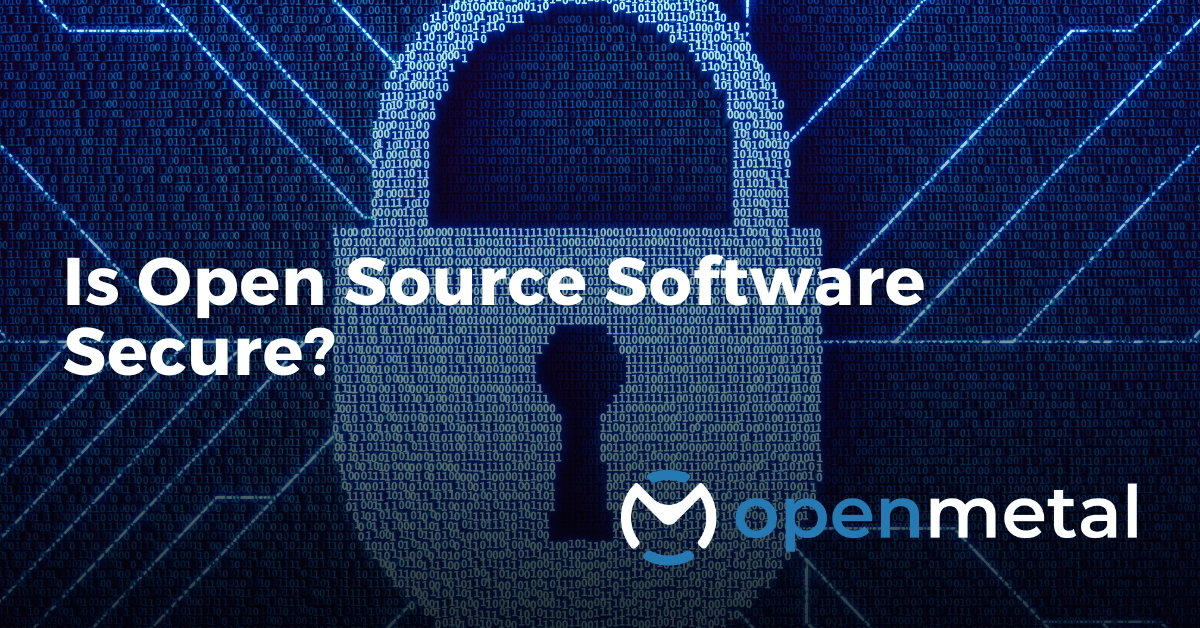Open source software (OSS)’s source code is available for anyone to see, modify, and distribute. This approach has led to the myth that open source software is too insecure for businesses to realistically use it for anything important. Having its source code in the open might make you think that this type of software is more vulnerable. But surprisingly, open source is often more secure than closed source/proprietary software. Here’s why:
Security Through Transparency
One of the main benefits of OSS is that it is transparent. The source code is available for anyone to inspect, which means that security researchers can more easily find and fix vulnerabilities.
This is in contrast to closed source software, where only the creators can discover any potential issues or bugs. This can make it more difficult to find and fix vulnerabilities, as they may go unnoticed for a longer period of time. If a proprietary piece of software has a team of 10 people responsible for it, that means that likely only those 10 people will ever review it. Issues can (and do) easily slip under the radar.
With open source, there may be hundreds or even thousands of people using, reviewing, and troubleshooting the code. There is far more opportunity for someone to notice and patch any vulnerabilities or flaws.
Open Source Software Has a Proven Track Record
There are many examples of OSS that are widely used and considered to be very secure. For example, the Linux operating system is used by millions of people around the world and is known for its security. Linux has over 15,000 contributors – an almost unimaginable number of people to have working on a piece of proprietary software! Other examples of both popular and secure OSS include the Apache web server and the OpenSSH secure shell protocol.
While any software implementation can theoretically be breached, there are far fewer cases of open source software issues. How often do we hear about yet another security issue or data leak from the big companies? It’s so bad that most people have become numb to them at this point. When you start to consider just how many cybersecurity breaches have happened to large, supposedly-secure businesses using supposedly-secure proprietary software, you’ll think again about open source being the vulnerable method!
It’s How You Implement Software That Matters
 Think of open source software code as the blueprint for a building. Are burglars able to break into that building just because they can see its design? No! The blueprints (source code) reveal the layout, but they don’t tell you where the alarm system is located or the combination to the safe.
Think of open source software code as the blueprint for a building. Are burglars able to break into that building just because they can see its design? No! The blueprints (source code) reveal the layout, but they don’t tell you where the alarm system is located or the combination to the safe.
While an attacker might understand the underlying security mechanisms, the actual “keys” to the system – encryption keys, access credentials, configurations, etc. – remain separate and secure. These are what truly safeguard the system and they are never part of the publicly available source code.
Even if an attacker did find a vulnerability, without the proper keys and configurations, they wouldn’t be able to gain access or compromise the system. Keeping the core code open for scrutiny but sensitive information separate greatly strengthens your overall security.
Pressure From the Community
Imagine doing your job with a thousand other people checking and correcting what you create! It sounds unpleasant, but this public scrutiny is what benefits open source software development.
Unlike closed source software where a limited team reviews the code, OSS development happens under a public microscope. Knowing that countless eyes, including security researchers and developers with diverse skillsets, will be examining the code, creators prioritize secure coding practices from the start.
The open source community holds developers accountable for maintaining high security standards. If developers neglect best practices or release code with known vulnerabilities, they face widespread criticism and potential loss of trust. This pressure to maintain good practices incentivizes developers to pay attention to security throughout the development lifecycle.
Why Open Source Software Makes Sense for Businesses
Open source software is often free to use and distribute. This can save organizations a significant amount of money on licensing costs. OSS is also generally more customizable than closed source software. Businesses can tailor the software to their specific needs and integrate with other programs easily.
And as we’ve shown above, open source software can be just as secure as closed source software – and oftentimes more! The transparency of OSS allows for more frequent scrutiny of the code. The massive community of developers who contribute to OSS can help to identify and fix bugs faster than a smaller and often-overworked proprietary software team.
As long as you take care to implement it the right way, you can be confident in your use of open source software. If you’ve shied away from OSS in the past due to security concerns, we encourage you to take another look! You may just discover the perfect new solution for your business.
Read More on the OpenMetal Blog
Demystifying Open Source Cloud: What You Need to Know
In this comprehensive blog, we’ll dive deep into the concept of open source clouds and explore why they are the ultimate key to empowering organizations.
Removing Barriers for Open Source Infrastructure Adoption
Learn about the current challenges around the widespread adoption of OpenStack powered infrastructure, especially in the context of private clouds for SMBs.
Exploring and Comparing the Open Source Serverless Tools
In the realm of serverless computing, open source platforms like OpenFaaS, Knative, Nuclio, and Apache OpenWhisk have garnered significant developer attention.






































